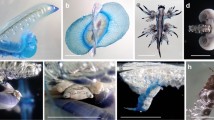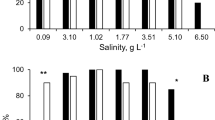Abstract
Seasonal dynamics of feeding activity, oil sac volume, gonad development, sex ratio and spawning periods in the two sibling species Calanusfinmarchicus and C. hyperboreus, the key zooplankton copepod organisms throughout the northern Atlantic waters, were studied simultaneously in Malangen, northern Norway, during 1992. We were also tracing differences in surface- and deep-dwelling components of these populations in terms of oil sac volume and gonad development during the time period when the G1 is preparing for a subsequent generation (G2) or hibernation. The main difference in the life cycle strategies of these species is the earlier maturation and spawning of C. hyperboreus. No feeding activity in either of the two species was found in February, but both commenced feeding in March, prior to the spring phytoplankton peak. The larger copepod, C. hyperboreus, had a more intensive energy deposition than C. finmarchicus. The period of active feeding was much shorter for the former species, only from March through July in copepodite stages CIV and CV, and even less in females – March and April. Basically, a similar pattern of seasonal changes in gonad length and lipids was observed in the two species. In June, oil sacs in the surface- and deep-dwelling specimens were about equal, during the rest of the year, lipids in the deep CVs exceeded those in the surface. We propose that as copepods accumulated sufficient lipid reserves, they started to descend, while others, containing less fat, stayed in the upper layers feeding. The mean length of the gonads in the surface-dwelling copepods was consistently less than in their deep counterparts from October to February, so that gonad development at the expense of accumulated reserves during resting stage was confirmed. C. finmarchicus males were found in considerable numbers only in February and March, and were only occasionally found in the upper layers (0–100 m), while adult male C. hyperboreus were present from October to March, but were never found in the surface layers. The differences in life cycle timing among the two species are discussed in relation to tradeoffs with regard to foraging strategies, generation numbers, bioenergetics and predator avoidance.
Similar content being viewed by others
Author information
Authors and Affiliations
Additional information
Received: 31 March 1999 / Accepted: 23 November 1999
Rights and permissions
About this article
Cite this article
Pasternak, A., Arashkevich, E., Tande, K. et al. Seasonal changes in feeding, gonad development and lipid stores in Calanusfinmarchicus and C. hyperboreus from Malangen, northern Norway. Marine Biology 138, 1141–1152 (2001). https://doi.org/10.1007/s002270100553
Issue Date:
DOI: https://doi.org/10.1007/s002270100553




